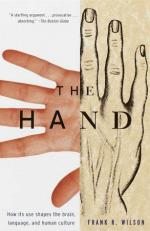
|
| Name: _________________________ | Period: ___________________ |
This test consists of 15 multiple choice questions and 5 short answer questions.
Multiple Choice Questions
1. What can can restore feeling to one who has lost a sense of connection with their body and enable movement again?
(a) Visualization.
(b) Regeneration of nerve cells.
(c) Small jolts of electricity to muscles.
(d) The awareness of the effect of the brain on controlling movement.
2. What helps the high school teacher?
(a) Her husband.
(b) A government grant.
(c) Feldenkrais.
(d) Determination.
3. To what do writing and drawing relate?
(a) Seeing and hearing.
(b) Touch and sight.
(c) Thinking.
(d) Many other skills using small tools.
4. How does Wilson learn that cooking is a specific skill using hands to produce an immediate sense of achievement?
(a) Working as a sous chef.
(b) Working as a meal planner in a posh restaurant.
(c) Eating at LuLu's restaurant
(d) Talking with Reed.
5. Who is an Israeli physicist mentioned in this chapter?
(a) Moshe Feldenkrais.
(b) David Golems.
(c) Jonathon Fleishman.
(d) Abraham Disera.
6. What does Wilson say laboring in the kitchen takes?
(a) Strong physical stamina.
(b) The ability to ignore heat.
(c) Strong emotional health.
(d) The ability to distinguish among subtle flavors.
7. What is a second language requirement?
(a) The ability to put words together in a chain or cluster.
(b) The ability to form the tongue into vowel shapes.
(c) The ability of the brain to understand the connection between concrete objects and their abstract names.
(d) The ability to hear.
8. How many Feldenkrais sessions does it take to effect a change in a woman with torsion dystonia?
(a) 12.
(b) 9.
(c) 3.
(d) 1.
9. What does Wilson say is an emotional experience?
(a) Completing a perfect, nine-course meal.
(b) Learning a new skill.
(c) Food.
(d) Interacting with an aclaimed chef.
10. How does Greenfield say she knows how a child will solve Greenfield's stick puzzle?
(a) By knowing if the child can read.
(b) By knowing the child's age.
(c) By observing which foot the child starts out on when walking.
(d) By observing which thumb is larger.
11. With whom does the University of New Mexico perform a study about communicative movements?
(a) Stanford University.
(b) UCLA.
(c) Harvard.
(d) Gallaudet University.
12. How does black magic differ from white magic regarding a patient's belief?
(a) White depends on the patient's belief in the goodness of God.
(b) It does not differ.
(c) Black magic does not exist.
(d) Black depends on the patient's belief in death.
13. Who is Reed Hearon?
(a) The owner of LuLu's restaurant.
(b) Wilson's co-writer.
(c) A math professor at Yale.
(d) The most famous chef in the United States.
14. What can both humans and primates make?
(a) Maps.
(b) Pictures.
(c) Pods.
(d) Complex tools.
15. What is sometimes attributed to intelligence or gender?
(a) Coordination.
(b) Good penmanship.
(c) The uses to which one puts the hand.
(d) Which hand one uses as the dominent hand.
Short Answer Questions
1. Why don't the ground mammals at this time eat the fruit in the trees?
2. What is a polylith?
3. What does the beginning of this chapter say the hand been used throughout its long history?
4. By what age do children become improvisers who behave with intelligence?
5. What does Feldenkrais facilitate?
|
This section contains 554 words (approx. 2 pages at 300 words per page) |

|




